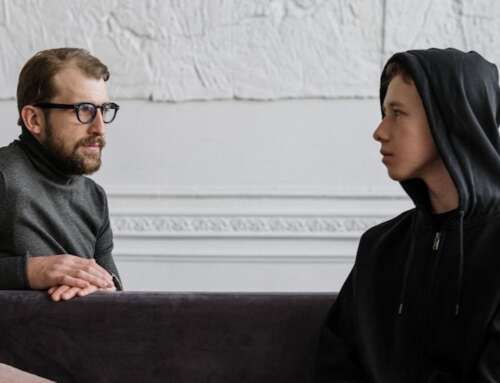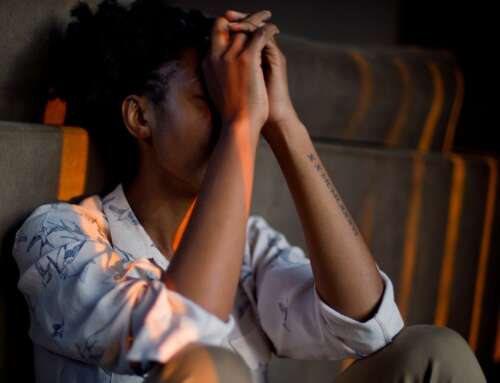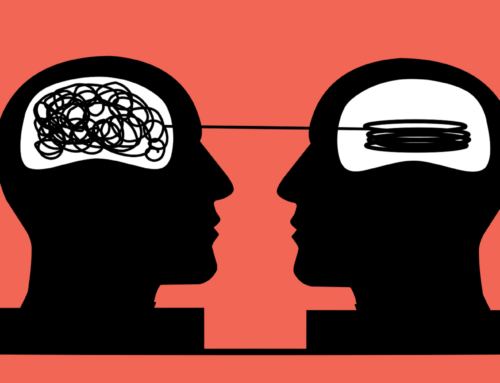We need to have more conversations with young people about mental health.
In the 2017 Mission Australia Youth Survey Report, mental health was rated by young people as the most important issue affecting Australia today [1]. While the majority of young people reported feeling optimistic about the future, they also saw mental health as one of the major barriers to achieving their work and study goals.
Issues like anxiety, depression and substance misuse can have a devastating effect on individuals and communities, and if not addressed early, can impact on a young person’s ability to work, socialise and function throughout their life.
Of the people who experience a mental health disorder in their lifetime, half of those will start having problems before the age of 14 [2]. Early detection and intervention are therefore vital to improving the wellbeing of young people who are struggling, preventing the tragedy of suicide, and helping them to flourish in the future [3].
But despite this, most young people don’t seek professional help to manage their mental health [4]. And those who are in most need of support are the least likely to seek it.
October is NSW Mental Health Month, so we’re taking some time to talk about what schools can do to support students who are struggling.
Why aren’t young people asking for help?
One of the biggest reasons young people don’t seek professional help is stigma. One type of stigma is the actual or perceived prejudice directed towards people with mental health problems in the community [5]. But according to Dr Claire Kelly, Manager of Youth Programs at Mental Health First Aid Australia, self-stigma can be a bigger barrier for young people when it comes to accessing support. Self-stigma is the internalisation of negative attitudes and beliefs about mental health issues by those who are experiencing them, and has a negative impact on self-efficacy and self-esteem.
Another major barrier to help-seeking is poor mental health literacy [5]. Young people often have difficulty understanding their psychological distress and knowing whether or not their experience is ‘normal’. They may be unsure whether they’re in need of professional support, and may feel confused and isolated. Poor mental health literacy can also make it hard for young people to help family or friends who are suffering.
A third major barrier to help-seeking is a desire for self-reliance and autonomy. Many young people are reluctant to seek help from others, instead preferring to manage their mental health themselves. According to Dr Kelly, a lot of young people believe “I should be able to cope with this on my own”.
So what makes young people more willing to ask for help? Research shows they are more likely to seek help if they believe services will be beneficial and trustworthy, if they have a history of positive experiences, and if they have encouragement from friends and family [5, 6]. And they’re more likely to seek help if the support can be accessed online, through services like eHeadspace [7].
How can schools increase help-seeking behaviour?
Teachers can reduce stigma and make mental health a normal topic of conversation by having regular discussions about mental health in the classroom. Education about the signs and symptoms of depression, anxiety and substance misuse will help to improve mental health literacy. And personal experiences of mental health, when shared in a safe and supportive environment, can combat stigma, reduce loneliness and isolation, and empower students to seek further help. ReachOut.com provides good resources for teachers, to help them have these conversations in the classroom.
It’s important to give students clear and accurate information about the types of help available, including formal and informal supports. Adolescents often turn to their peers first, and we know that encouragement from loved ones is key to increasing help-seeking behaviour. So it’s good to educate students on how to identify signs that their friends and family may need help, and where to access it. Give them information about key contacts like Kids Helpline, headspace and their local GP. R U OK?’s education resources also provide tips for supporting someone in their life who is struggling with mental health or suicidal thoughts.
We need to challenge common myths and misconceptions about mental health treatment. For instance, we often hear people dismiss a young person’s distress, self-harm or suicidal thoughts as “just attention-seeking”. Dr Kelly from Mental Health First Aid reminds us that “seeking attention means a person needs attention” and “a cry for help means a person needs help”. It’s important for young people to know that if a friend discloses thoughts of suicide this should be taken seriously, and a trusted adult needs to be involved immediately.
It’s important that we explore with students the options available for treatment. For example, sometimes you don’t click with a counsellor or psychologist straight away, and it can take time to develop a trusting relationship. But it’s also OK to try a different therapist if you really don’t feel comfortable. This is important, given that rapport with health professionals is one of the key factors affecting adolescents’ willingness to seek professional help.
It can also help for young people to know they have a right to be involved in decisions about their own mental health care. Health professionals, in collaboration with their parents or caregivers, will aim to respect their autonomy and involve them in decision-making wherever possible.
The value of theatre-based school programs
One way to encourage help-seeking is through storytelling and live theatre. Theatre in education companies like Brainstorm Productions can provide a starting point for conversations about mental health in a safe and familiar environment.
The high school performance ‘Wired‘ aims to improve mental health literacy, reduce stigma and encourage help-seeking through an engaging and relatable narrative. It explores some of the causes and symptoms of mental health issues, such as anxiety, depression and panic attacks, and the experience of seeking treatment. It provides practical strategies for self-management, including slowed breathing, exercise, breaking overwhelming tasks into manageable steps, setting realistic goals, and talking to family and friends. And it shows two characters connecting through shared experiences, who support each other to seek help and make changes in their lives.
The performance is followed by a discussion with the actors, where students have the opportunity to further explore the issues. They’re given additional information about crisis services and other sources of support. And they’re encouraged to speak to teachers, school counsellors, parents and GPs if they have concerns about their mental health, or that of a friend. Follow-up activities help teachers unpack the issues with their students when they return to the classroom.
By normalising discussions about mental health, and providing simple and practical information, we can break the silence and make it easier for young people to seek help when they need it.
– Dr Ameika Johnson, Brainstorm Productions
Image Source: Brainstorm Productions
References
[1] Bullot A., Cave, L., Fildes, J., Hall, S. and Plummer, J. (2017). Mission Australia’s 2017 Youth Survey Report, Mission Australia.
[2] Kessler, R.C., Berglund, P., Demler, O., Jin, R., Merikangas, K.R., & Walters, E.E. (2005). Lifetime prevalence and age-of-onset distributions of DSM-IV disorders in the National Comorbidity Survey Replication. Archives of General Psychiatry, 62, 593-602.
[3] McGorry, P. (2013). Prevention, innovation and implementation science in mental health: The next wave of reform. British Journal of Psychiatry, 202, s3–s4.
[4] Reavley, N.J., Cvetkovski, S., Jorm, A.F., & Lubman, D.I. (2010). Help-seeking for substance use, anxiety and affective disorders among young people: Results from the 2007 Australian National Survey of Mental Health and Wellbeing. Australian and New Zealand Journal of Psychiatry, 44, 729–735.
[5] Gulliver, A., Griffiths, K.M., & Christensen, H. (2010). Perceived barriers and facilitators to mental health help-seeking in young people: A systematic review. BMC Psychiatry, 10, 113.
[6] Barker, G. (2007). Adolescents, social support and help-seeking behaviour: An international literature review and programme consultation with recommendations for action. Geneva: World Health Organization.
[7] Rickwood, D.J., Mazzer, K.R., & Telford, N.R. (2015). Social influences on seeking help from mental health services, in-person and online, during adolescence and young adulthood. BMC Psychiatry, 15, 1-9.
Image by Fernando from Unsplash







Leave A Comment